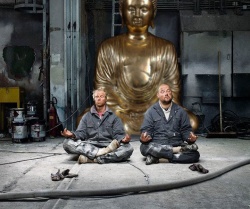Vajraparyankasana
Revision as of 21:25, 1 April 2014 by VTao (talk | contribs) (Created page with "thumb|250px| Vajra-paryanka-asana; (sometimes referred to as Padma-asana or Vajra-asana). The "adamantine throne" position, made with th...")
Vajra-paryanka-asana; (sometimes referred to as Padma-asana or Vajra-asana). The "adamantine throne" position, made with the legs crossed at the ankles, and both soles of the feet showing, pointed upward. This is the posture used in meditation and it is most commonly used to depict the enlightened Buddha. The historical Buddha, once he is fully enlightened, will be represented in this posture when he is seated.
